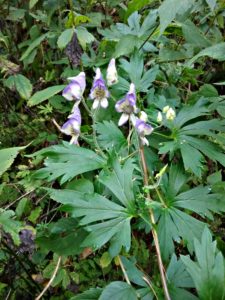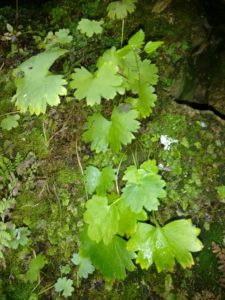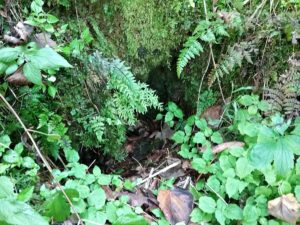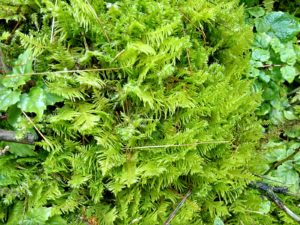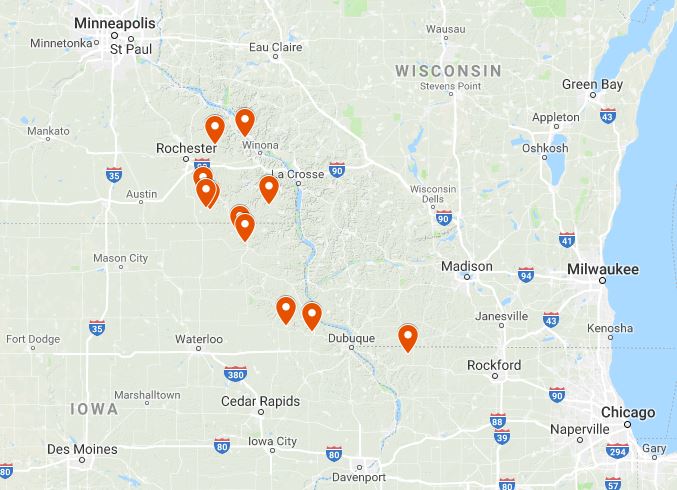Exploring Pleistocene botanical refugia of the Upper Midwest.
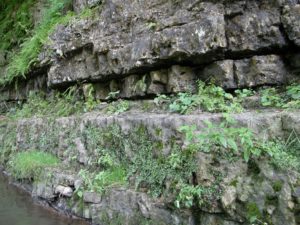 The Driftless Area is a region of the upper Mississippi basin without geological evidence of glaciation during the Pleistocene. It is well known in biogeography due to its status of paleorefugium, demonstrated for many different relictual species and populations of plants and animals. The Driftless Area comprises unique ecosystems such as the algific talus slopes that host some of the oldest plant communities in the region. These habitats host a distinct combination of boreal and lowland bryophytes that remains vastly under-explored. This project will assess the relictual status of some boreal mosses present in the Driftless Area using DNA fingerprinting.
The Driftless Area is a region of the upper Mississippi basin without geological evidence of glaciation during the Pleistocene. It is well known in biogeography due to its status of paleorefugium, demonstrated for many different relictual species and populations of plants and animals. The Driftless Area comprises unique ecosystems such as the algific talus slopes that host some of the oldest plant communities in the region. These habitats host a distinct combination of boreal and lowland bryophytes that remains vastly under-explored. This project will assess the relictual status of some boreal mosses present in the Driftless Area using DNA fingerprinting.
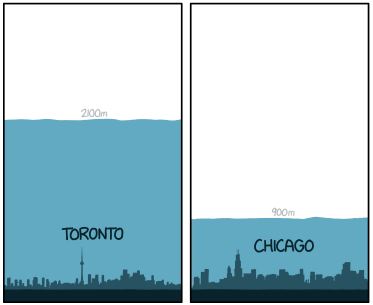
Depth of the ice sheet covering the location of Toronto and Chicago during the Last Glacial Maximum compared with the current skyline. (Cropped from xkcd. https://xkcd.com/1225/)
Description: Throughout the Pleistocene, a significant area of the US Midwest was periodically covered by a glacial ice sheet (up to 3,000 feet thick in the Chicago area) that obliterated every living organism. The last of these episodes, known as the Last Glacial Maximum, ended just about 18,000 years ago, leaving behind bare glacial sediments (known as “drift” or “till”). This means that virtually all the forests, prairies and native ecosystems we can see today in the area are the result of the colonization of plants and animals after the retreat of the ice sheet. Glaciations are compared to an ecological “reset button”.
There is a region in the upper Mississippi basin without deposits of glacial sediments known as the Driftless Area (DA); it encompasses part of the states of Minnesota, Wisconsin, Iowa and Illinois. Geological evidence suggests that the DA was indeed not covered by ice during the most recent glacial episodes; it was, to a certain extent, like an island in an ocean of ice. The DA was what we call a glacial refugium where the populations of some species of plants and animals could survive during the glaciations. This explains why, today, we can find there several very unique species that are absent in the rest of the region or that only re-appear many miles up in the north. Some of those relictual populations have survived until the present; they represent an invaluable component of the natural heritage of the American Midwest.
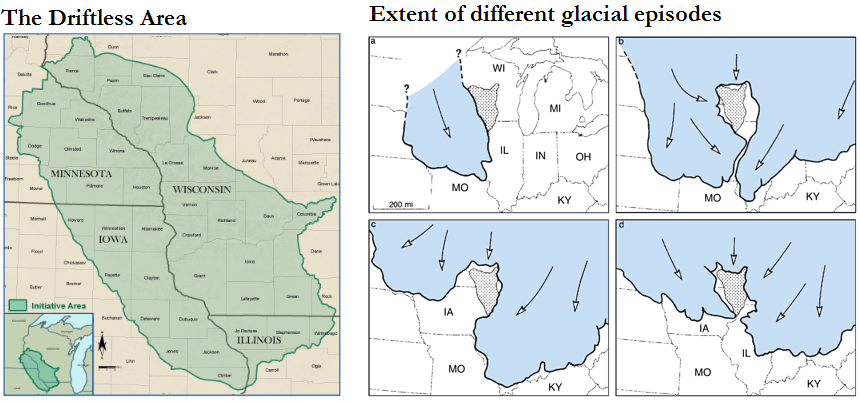
Left: The Driftless Area (Source: USDA). Right: Maximum extent of the ice sheet (blue) during some relevant glacial episodes: (a) early Pre-Illinois (approx 1,000,000 years ago); (b) late Pre-Illinois (approx 600,000 years ago); (c) Illinois (approx 250,000 years ago); (d) late Wisconsin (approx 22,000 years ago). The Driftless Area is shown in grey; arrows indicate direction of ice movement. (Source: Illinois State Geological Survey)
We are particularly interested in a distinct feature of the DA: the algific talus slopes. They are karstic limestone banks that hold frozen pools of water inside and release cold air through vents in the rock. These air currents create a microclimate around the vents that is consistently cool even during the summer. Many glacial relicts have survived in these slopes during millennia and predate the latest glaciations. A good example is the tiny snail Discus macclintocki that was thought to be completely extinct until it was found in the DA. The flora of these slopes is also special, with many rare species such as the Northern wild monkshood (Aconitum noveboracense) or Sullivant’s coolwort (Sullivantia sullivantii).
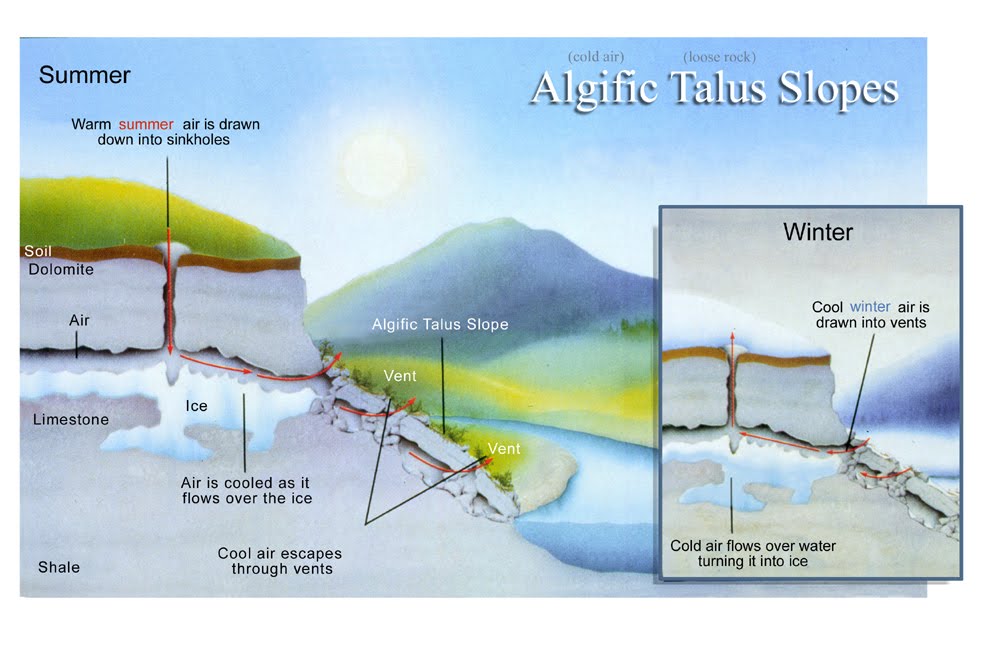
Diagram of an algific talus slope and the dynamic of the air currents. Click to enlarge. (Source: The Nature Conservancy)
The algific talus slopes can also host very distinct bryophytes (mosses and allied plants). You can find here species with disjunct distributions; species that might be present in the boreal biomes of the north or the montane forests of the Appalachians but are, otherwise, absent or extremely rare in the Midwest. This unique ecosystem, home of some of the most ancient plant communities in the region, is endangered by the expansion of invasive species and the reduction of the ice deposits due to climate change. A few slopes (out of hundreds) were sparsely sampled in the 20th century, but the role of these sites as refugia for bryophytes during the Pleistocene has never been tested..
We want to test to what extent some of the relevant boreal bryophyte species present in the DA are preglacial relics that have survived in situ during the past millennia. The answer is not obvious since mosses are dispersed by spores and their biogeography frequently diverges from the patterns followed by other plants. If a moss population of the DA is relictual, it will show a higher genetic diversity than the populations that colonized an area after the retreat of the ice sheet, and this can be tested by different DNA profiling techniques. The results will help us to understand how mosses are dispersed and how they react to environmental change through time.
